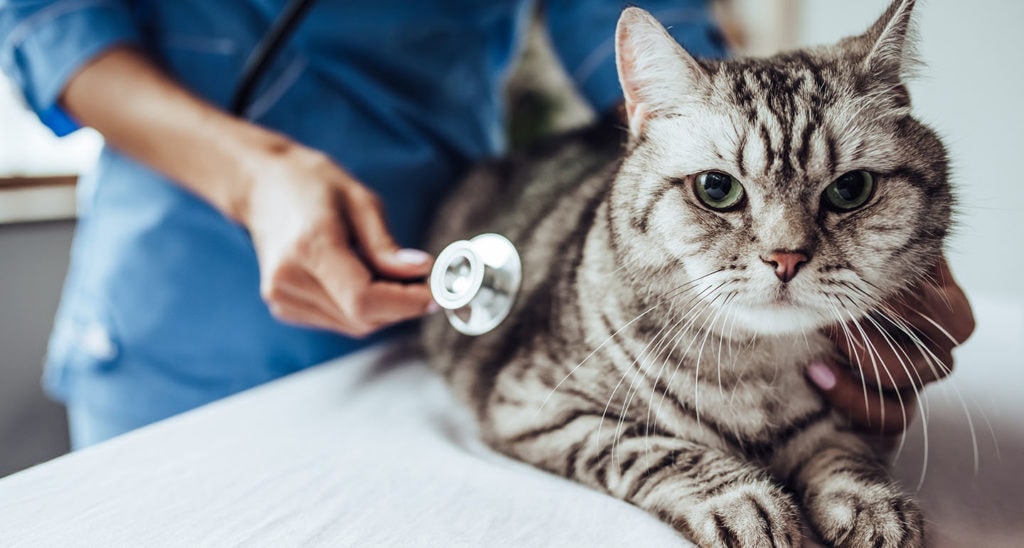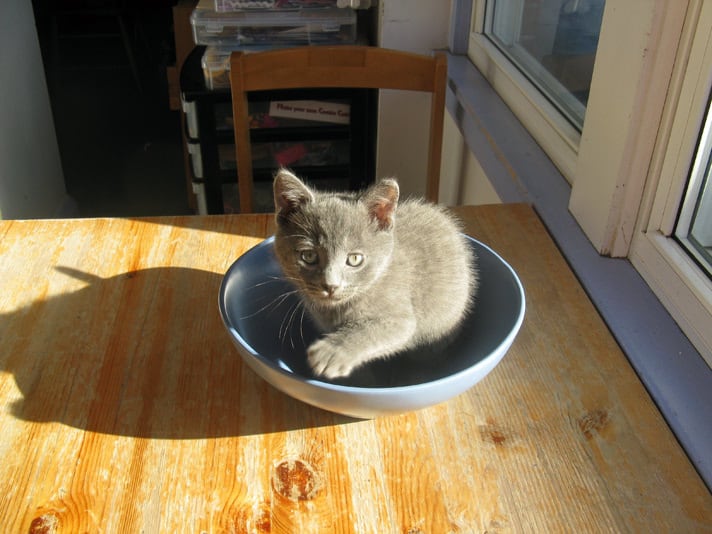Cat vaccinations, like regular physical examinations and quality nutrition, are essential parts of your pet’s health program. Thanks to vaccinations, cats no longer have to suffer from several potentially fatal diseases. Preventing diseases is much simpler, kinder and usually more affordable than treating them.
Even though vaccinations are a welcome advancement in feline healthcare, they do include some risk. With all the information (and misinformation) circulating about vaccines, it’s wise to learn about their pros and cons of vaccines for pets. Armed with that knowledge, you and your veterinarian can work together to keep your precious cat healthy.
What Vaccines Do Cats Need?
Vaccinations are given to prevent disease, not as a treatment for sick cats. They’re divided into core and noncore categories. All cats should receive core vaccines, which are the ones that guard against common and/or severe contagious diseases.
Core vaccines for cats:
- Rabies – considered a core vaccine when required by law or wherever rabies is present
- Feline Viral Rhinotracheitis (FVR) – herpes virus
- Feline Panleukopenia (FP) – feline distemper
- Feline Calicivirus (FCV)
Noncore vaccines are given to certain cats based on factors such as lifestyle, environment and general health.
Common noncore vaccines for cats:
- Feline Leukemia Virus (FeLV) – All kittens should be vaccinated against feline leukemia virus with the need for future vaccinations determined by the pet’s risk factors.
- Chlamydophila Felis
- Bordetella Bronchiseptica
Kittens generally start receiving vaccinations between 6 and 8 weeks of age. Boosters are administered at 3- to 4-week intervals until they are 16-20 weeks old. These boosters are essential or else the immunity provided by the mother’s milk might render the vaccinations useless.
If an older cat’s vaccination history is unknown, it’s best to consider them unvaccinated. Most adult cats who are “unvaccinated” can be vaccinated adequately in two appointments scheduled 3-4 weeks apart. Booster vaccines usually are given to adult cats every 1-3 years, depending on the vaccine type and the cat’s risk factors.
Common Cat Vaccinations
Vaccines protect pets by exposing them to 1) disease-causing microorganisms that have been modified so they can’t cause the illness in question, or 2) small parts of those organisms that induce an immune response. By introducing a cat to this controlled stimulus, the body is prepared to handle future exposures.
Rabies Vaccine
Usually transmitted through the bite of an infected animal, rabies attacks the central nervous system and is fatal in cats. Wildlife such as coyotes, skunks and bats are typical carriers.
Outdoor cats are more likely to be exposed to the virus, but indoor cats also are vaccinated due to the disease’s severity and the risk infected-cats pose to people. Most states require that cats be vaccinated against rabies.
The cat vaccination schedule for rabies depends on the vaccine used, but all of them begin no earlier than 12 weeks of age. There’s a booster in about one year, after which it may be given annually or every three years, depending on vaccine type.
FVRCP Vaccine (feline viral rhinotracheitis, calicivirus and panleukopenia)
All three of these diseases are highly contagious. Feline viral rhinotracheitis and calicivirus have similar symptoms, including sneezing, fever, swollen eyes, lethargy and discharge from the eyes and/or nose. Cats also can develop ulcers of the mouth, eyes or skin.
Panleukopenia, also known as distemper, causes fever, diarrhea, vomiting, nasal discharge and bone marrow suppression. This disease frequently is fatal.
Cats can be vaccinated against all three of these diseases at once with the FVRCP combination vaccine. The vaccination series begins at 6-8 weeks of age with a booster given every 3-4 weeks until kittens are 16-20 weeks old. An additional booster at 1 year of age also is needed. After that, the vaccine’s protection generally lasts for at least three years.
FeLV Vaccine (feline leukemia virus)
Cats infected with the feline leukemia virus often develop symptoms such as decreased appetite, digestive upset, poor coat condition, fever and swollen lymph nodes. As the disease progresses, the cat’s weakened immune system puts him at risk for other illnesses, including cancer, and usually is fatal given enough time.
Cats most often are exposed to the virus through the bite of an infected cat. Other risk factors include mutual grooming, shared litter boxes and communal food bowls. Kittens are much more susceptible to FeLV than adult cats. A free-roaming outdoor or indoor/outdoor lifestyle is also a major risk factor.
While not technically a core vaccine, the FeLV vaccine should be given to most kittens. They will receive two doses 3-4 weeks apart, starting at about 8 weeks of age, and a booster at their first annual adult visit.
After these initial vaccines, the booster schedule depends on the specifics of the case, but most at-risk cats are revaccinated every 2-3 years. Adult, indoor-only cats typically do not need to receive boosters unless they are living with a FeLV-positive feline housemate.
Other Vaccines (FIV, Bordetella, Chlamydophila and FIP)
Feline immunodeficiency virus (FIV) attacks a cat’s immune system, putting him at risk for other infections and diseases. Symptoms may include fever, weight loss, poor coat condition, digestive upset, hair loss, respiratory issues and oral inflammation. Cats can be infected only by other cats, primarily through bite wounds. However, the FIV vaccine provides less-than-ideal protection against the disease and is associated with other complications, so only very high-risk cats should be vaccinated.
Bordetella bronchiseptica can cause respiratory disease, but it is rarely a significant problem for healthy cats. Kittens or cats with suppressed immune systems are more likely to catch and show symptoms of a Bordetella infection. When deemed necessary, the vaccine is given intranasally.
Chlamydophila felis causes feline conjunctivitis and respiratory disease. If contracted, cats usually make a speedy recovery after a course of antibiotics. Cats who avoid crowded places like boarding facilities are unlikely to be exposed to it. Effective vaccines are available for at-risk cats but are not given to most pets.
The feline infectious peritonitis (FIP) vaccine is rarely effective under real-world scenarios and should rarely (if ever) be given.
Cat Vaccination Schedule*
Lifestage
Age
Recommended Vaccines
Kitten

Around 8 weeks
Around 12 weeks
At least 16 weeks
Around 20 weeks
Feline viral rhinotracheitis, calicivirus and panleukopenia (FVRCP); Feline leukemia virus (FeLV)
FVRCP booster; FeLV booster; rabies vaccine if 12 weeks or older
FVRCP booster; rabies vaccine if not previously given
Possible FVRCP booster for at-risk kittens
Young Adult

Middle Aged
Senior
* Specifics may vary. Older kittens and cats who are behind on their vaccines or have an unknown vaccination history generally can be caught up in two visits for vaccines given 3-4 weeks apart.
Frequently Asked Questions About Cat Vaccinations
With all the variables surrounding cat vaccines, it’s normal to have questions. We’ve answered some of the most frequently asked questions about cat vaccinations.
Q:
What vaccines do cats need?
A:Generally, all cats should be vaccinated against feline viral rhinotracheitis, calicivirus and panleukopenia. Most also need rabies vaccines. Kittens should be vaccinated for the feline leukemia virus, as well, but the need for continued vaccination in adult cats is assessed on a case-by-case basis. Vaccinations for feline immunodeficiency virus (FIV), Chlamydophila and Bordetella can be considered in rare cases, but the feline infectious peritonitis (FIP) vaccine should almost never be given.
Q:
How much do cat vaccinations cost?
A: Vaccination costs vary depending on the geographic location, the clinic and the type of vaccines given. Core vaccines usually run around $10-$20 each. You also can look into local free or low-cost vaccination clinics run by nonprofits. Regardless of the cost, it’s decidedly more affordable and humane to vaccinate your cat than to have to deal with a preventable illness.
Q:
How often should I get the rabies vaccine for my cats?
A: Rabies vaccines first are administered when a kitten is at least 12 weeks old with a booster given about one year later. Different kinds of feline rabies vaccines are available, and the length of time between subsequent boosters depends on the type used. The manufacturer’s label has specific directions regarding revaccination intervals.
Q:
What are the common side effects of vaccines for cats?
A:
Cats don’t usually show serious side effects from vaccinations. You might see a little lethargy or swelling and soreness around the injection site, similar to what humans experience after receiving a vaccine. If the vaccination is given intranasally, a little sneezing or a runny nose would not be unusual. Call your veterinarian if any of these symptoms persist past a couple of days.
Injection site sarcomas, a type of cancer, are a rare-but-devastating adverse event associated with some feline vaccines. To aid in their treatment and identification, cats are vaccinated at specific locations low on their legs.
While it’s good to be aware of potential side effects, the benefits of appropriate vaccination far outweigh any risks. We’re fortunate to live in a time when serious feline diseases can be prevented so easily.
Read More
Share:













